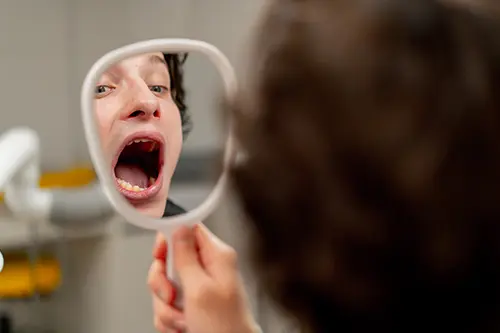Reviewed by Dr. Kerri Font, DDS
Reading time: five minutes.

Gum recession is more than just a cosmetic issue—it’s a sign that your oral health may be at risk. Receding gums, also known as gingival recession, is a dental issue that can lead to serious complications if left untreated.
When the gum tissue surrounding your teeth wears away, it exposes the tooth roots, which can result in increased tooth sensitivity and a higher risk of tooth loss due to periodontal disease.
This blog will help you identify symptoms so that you can take proactive steps to maintain your oral health.
Table of Contents
- Causes of Receding Gums
- Symptoms of Receding Gums
- Treatments for Receding Gums
- Maintaining Healthy Gums
- Highlands Ranch Periodontics: Your Gum Specialist
Key Takeaway
You can’t completely reverse receding gums, but treatments can help restore gum health and prevent further damage, especially if the recession is caught early.
Causes of Receding Gums
Several factors can contribute to gum recession, including:
Aggressive Tooth Brushing
When you brush your teeth too hard or use a hard-bristled toothbrush, you can wear down both your enamel and gum tissue. This constant pressure can cause the gums to pull away from the teeth, exposing the roots and leading to gum recession.
Gum Disease
This condition is caused by the buildup of harmful bacteria in the mouth, which leads to inflammation and infection of the gum tissue. As the infection progresses, the gum tissue and supporting bone structures deteriorate, causing the gums to recede.
Tobacco Products
The use of tobacco products, including cigarettes and chewing tobacco, has a direct impact on gum health. Tobacco use reduces blood flow to the gums, depriving them of essential nutrients and oxygen. Over time, tobacco use can lead to significant gum recession as the tissue deteriorates and pulls away from the teeth.
Hormonal Changes
Hormonal changes, particularly in women, can make gums more sensitive and prone to recession. Fluctuations in hormones during puberty, pregnancy, and menopause can affect the blood supply to the gum tissue, making it more susceptible to inflammation and recession. During these times, the gums may respond more aggressively to plaque buildup, increasing the risk of gum recession.
Genetics
If gum disease or thin gum tissue runs in your family, you may be more prone to gum recession. Some people are genetically predisposed to have thinner or weaker gum tissue, which can be easily damaged.
Crooked Tooth or Misaligned Bite
A crooked tooth or misaligned bite can exert uneven pressure on your gums and teeth. When your teeth are not properly aligned, certain areas of your mouth may experience excessive force during chewing or brushing, leading to gum recession.
Poor Oral Hygiene
Poor oral hygiene is a leading cause of gum recession. When you neglect to brush and floss regularly, harmful bacteria build up in the mouth, leading to plaque and tartar formation. This buildup irritates the gum tissue, causing inflammation and eventually leading to gum recession.
Symptoms of Receding Gums
It’s important to seek professional help if you notice any signs of gum recession. Early intervention can prevent further damage and improve your gum health.
- Visible signs of receding gums: If your gums appear to be pulling away from your teeth, it’s time to consult with a periodontist.
- Tooth sensitivity: If you’re experiencing increased sensitivity, it could be a sign of exposed tooth roots.
- Loose teeth or gaps between teeth: These symptoms indicate that gum recession may be advancing.
Treatments for Receding Gums
Several treatment options are available. Your dentist or periodontist will determine the most effective approach for your situation.
- Deep cleaning: A deep dental cleaning will remove harmful bacteria and tartar from your teeth and gum line.
- Root planing: This procedure smooths the root surfaces, making it harder for bacteria to adhere. This procedure allows the gum tissue to heal and promotes gum reattachment
- Gum graft surgery: Surgical procedures, such as connective tissue grafts or soft tissue grafts, can restore lost gum tissue. This may involve using donor tissue to cover exposed tooth roots and create a healthier gum environment.
- Gum flap surgery: The dentist lifts the gums to expose the tooth roots and underlying bone. The dentist then cleans the tooth roots, removes inflamed gum tissue, and repairs any bone damage with grafts.
Can Receding Gums Be Reversed?
Reversing receding gums depends on how severe the recession is. Mild cases can often be managed with better oral hygiene and regular dental cleanings. However, severe cases usually need professional treatment. Though you can’t fully reverse gum recession, certain treatments can help restore gum health and stop it from getting worse.
Maintaining Healthy Gums
Follow these steps to maintain healthy gums and reduce your risk of gum recession:
- Use a soft toothbrush: Opt for a soft-bristled toothbrush to avoid damaging your gums.
- Practice gentle brushing: Brush your teeth gently to protect both your enamel and gum tissue.
- Avoid tobacco products: Quit smoking and avoid other tobacco products to improve your gum health.
- Regular dental checkups: Regular visits to your dentist for cleanings and checkups can help detect any issues early on.
- Proper oral hygiene: Brush twice daily, floss regularly, and use mouthwash to reduce the growth of bacteria and protect your gums.
Highlands Ranch Periodontics: Your Gum Specialist
Our periodontists Dr. Kerri Font, DDS, and Dr. Mike Norouzinia, DDS are dedicated to restoring your gum health. From prevention to advanced treatment options, we offer a comprehensive approach to address receding gums and other periodontal issues.
If you are searching for a ‘gum recession treatment in Highlands Ranch’ or the ‘best periodontist near me’ we can help! Call (303) 683-1144 to book an appointment or complete the online inquiry form.
